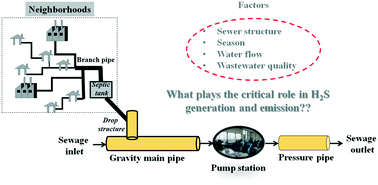Hydrogen sulfide generation and emission in urban sanitary sewer in China: what factor plays the critical role?†
Abstract
Identifying hydrogen sulfide (H2S) hotspots is critical for preventing/controlling odor and corrosion problems in sewer systems. However, relatively little is known regarding H2S hotspots and variation characteristics in China's urban sewer networks. A comprehensive field investigation was carried out on the impacts of sewer structures, season, water flow and wastewater quality on H2S emission. The results indicated that H2S diurnal variation mainly followed the dry weather flow fluctuation in gravity sewer networks. The manhole downstream of septic tanks was identified as a H2S emission hotspot due to potential significant sulfide generation in the septic tanks. The effect of temperature on H2S emission was related to variations in the sulfide production rate and flow turbulence at different locations in the sewer system. Significant reduction in sulfide concentration was observed with rainfall-derived high water flow rate. The local water quality was identified as a key factor for sulfide generation from different sites along the sewer system. These findings are useful in understanding and predicting H2S emission in China's sewer systems.



 Please wait while we load your content...
Please wait while we load your content...